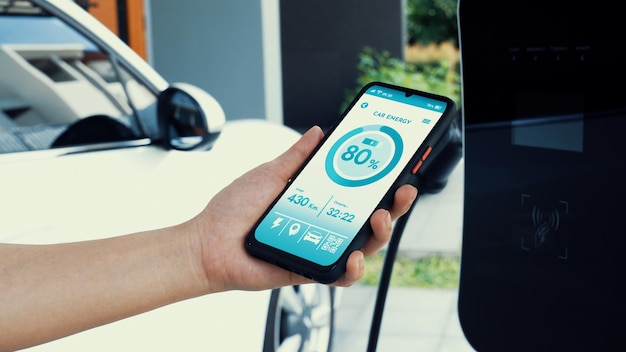Electric Vehicle Revolution: Transforming Home Garages with Charging Stations

The rise of electric vehicles (EVs) is reshaping home garages, necessitating the installation of charging stations for convenient and efficient vehicle power.
The automotive landscape is undergoing a seismic shift, with electric vehicles (EVs) rapidly gaining traction. As this trend accelerates, a quiet revolution is also taking place within our homes, specifically in our garages. The rise of electric vehicles: how charging stations will transform home garages is not just about swapping gasoline for electricity; it’s about reimagining our living spaces to accommodate a sustainable future.
The Electric Vehicle Revolution: An Overview
Electric vehicles are no longer a futuristic concept; they are a present-day reality. With advancements in battery technology, increased driving ranges, and growing environmental awareness, EVs are becoming increasingly popular. This shift necessitates a corresponding evolution in our home infrastructure, primarily the installation of charging stations in our garages.
This adaptation goes beyond simply plugging in a car. It involves understanding the different types of charging stations, assessing your home’s electrical capacity, and making informed decisions to ensure safe and efficient charging. The transformation of home garages into EV charging hubs marks a significant step towards a sustainable transportation ecosystem.

Understanding EV Charging Levels
When it comes to charging your electric vehicle at home, it’s crucial to understand the different charging levels available. Each level offers varying charging speeds and requires different electrical setups. Choosing the right level depends on your driving habits, available time for charging, and the electrical capacity of your home.
There are three primary levels of EV charging: Level 1, Level 2, and DC Fast Charging. Each has its own characteristics and suitability for different charging needs.
Level 1 Charging: The Basics
Level 1 charging is the most basic and often the slowest method. It uses a standard 120V household outlet, meaning no additional equipment or installation is required. While convenient, it provides a relatively slow charging speed, adding only a few miles of range per hour.
Level 2 Charging: The Standard for Home
Level 2 charging is the most common and practical option for home use. It requires a 240V outlet, similar to those used for dryers or ovens. This level significantly increases charging speed, adding a considerable number of miles per hour compared to Level 1. Installing a Level 2 charging station typically involves hiring an electrician to ensure proper wiring and safety.
- Speed: Significantly faster than Level 1 charging.
- Installation: Requires a dedicated 240V circuit and professional installation.
- Convenience: Ideal for overnight charging, providing a full charge by morning.
- Cost: Higher upfront cost due to equipment and installation.
Level 2 charging stations are also available as smart, connected devices. These smart chargers offer features such as remote monitoring, scheduling, and energy usage tracking. This allows EV owners to optimize their charging habits and take advantage of off-peak electricity rates.
Understanding the different charging levels is fundamental to making an informed decision about your home charging setup. While Level 1 charging may suffice for occasional top-ups, Level 2 charging generally provides the best balance of speed and convenience for daily use.
Assessing Your Home’s Electrical Capacity
Before installing an EV charging station, evaluating your home’s electrical capacity is essential. Overloading your electrical system can lead to tripped breakers, power outages, or even electrical fires. A thorough assessment ensures that your electrical infrastructure can safely handle the additional load of an EV charger.
Consulting a qualified electrician is the first step in this process. They can evaluate your electrical panel, wiring, and overall capacity to determine if upgrades are necessary.
Checking Your Electrical Panel
The electrical panel is the heart of your home’s electrical system. It distributes power to different circuits and protects against overloads. Determine the amperage rating of your main electrical panel. This information is usually printed on the panel itself or in your home’s electrical documentation.
Calculating Electrical Load
Next, calculate your existing electrical load. This involves adding up the amperage requirements of all major appliances and electrical devices in your home. Your electrician can help you with this calculation, ensuring that you account for all significant power draws.
Once the total load is calculated, compare it to the capacity of your electrical panel. If the existing load is close to or exceeds the panel’s capacity, upgrades will be necessary to accommodate the additional load of an EV charging station.
- Panel Upgrade: Replacing your existing electrical panel with a higher capacity model.
- Dedicated Circuit: Installing a dedicated circuit specifically for the EV charger.
- Load Management Systems: Implementing a system that dynamically adjusts the charging rate based on overall power usage.
Proper assessment of your home’s electrical capacity is not just a matter of convenience; it’s a critical safety measure. Taking the time to evaluate and upgrade your electrical system ensures the safe and reliable operation of your EV charging station for years to come.
Choosing the Right Charging Station
Selecting the right EV charging station for your home involves considering several factors, including charging speed, features, and budget. With a wide range of options available, it’s important to weigh the pros and cons of each to make an informed decision.
Several factors contribute to making the right decision. Consider what charger speed and features you desire, as well as your budget at the moment.
Evaluating Charging Speed Needs
The most crucial factor in choosing a charging station is the charging speed it offers. Level 2 charging stations are available with varying amperage ratings, typically ranging from 16 amps to 80 amps. The higher the amperage, the faster the charging speed.
Considering Smart Features
Many modern charging stations come equipped with smart features that enhance the charging experience. These features include Wi-Fi connectivity, mobile app control, scheduling capabilities, and energy usage monitoring.
Understanding Budget Constraints
The cost of EV charging stations can vary significantly depending on the brand, features, and charging speed. Set a budget beforehand and explore options within your price range. Consider the long-term savings in fuel costs and the environmental benefits when evaluating the overall value.
- Research: Read reviews and compare different models to get a sense of their performance and reliability.
- Compatibility: Ensure the charging station is compatible with your EV model and its charging port.
- Warranty: Check the warranty offered by the manufacturer to protect against defects and ensure peace of mind.
Choosing the right EV charging station is a balance of speed, features, and affordability. With careful consideration and research, you can select a charging station that meets your needs and enhances your EV ownership experience.

Installation and Safety Considerations
Proper installation is crucial for the safe and efficient operation of your EV charging station. Incorrect installation can lead to electrical hazards, equipment damage, or reduced charging performance. Adhering to safety guidelines and enlisting the help of qualified professionals is essential.
The electrical system must be handled carefully. Be sure to adhere to safety guidelines.
Hiring a Qualified Electrician
Unless you have extensive electrical experience, it’s best to hire a qualified electrician to install your EV charging station. Electricians are trained to handle electrical wiring, ensure compliance with local codes, and prioritize safety.
Following Local Codes and Regulations
EV charging station installations are subject to local codes and regulations that vary by jurisdiction. These codes ensure that installations meet safety standards and comply with permitted electrical practices. An electrician can ensure that your installation adheres to all applicable codes.
Implementing Safety Measures
Implementing safety measures is crucial to prevent electrical hazards and protect your home. These measures include installing surge protectors to guard against power surges, using appropriate wiring and connectors, and regularly inspecting the charging station for damage.
- Permits: Obtain any necessary permits before starting the installation process.
- Inspection: Schedule an inspection after installing the charging station to ensure it meets safety standards.
- Maintenance: Perform routine maintenance on the charging station to keep it in good working condition.
Prioritizing safety during the installation and operation of your EV charging station is essential. By following safety guidelines, hiring qualified professionals, and adhering to local codes, you can ensure a safe and reliable charging experience.
The Future of Home Garages: Smart and Sustainable
The integration of EV charging stations into home garages is just the beginning of a broader transformation towards smart and sustainable living. As technology advances and environmental consciousness grows, our garages are poised to become even more connected, efficient, and eco-friendly.
As tech advances, there are many new possibilities for your garage. It may be even more connected and efficient.
Smart Home Integration
EV charging stations can be seamlessly integrated with smart home systems, allowing you to control and monitor charging from anywhere. This integration enables features such as voice control, automated scheduling, and energy management.
Energy Storage Solutions
Combining EV charging stations with energy storage solutions, such as solar panels and battery systems, can further enhance sustainability. These systems allow you to generate and store your own electricity, reducing reliance on the grid and lowering energy costs.
Vehicle-to-Grid (V2G) Technology
Vehicle-to-Grid (V2G) technology enables EVs to not only draw power from the grid but also send power back to it. This bidirectional energy flow can help stabilize the grid, reduce peak demand, and create new revenue opportunities for EV owners.
- Wireless Charging: Explore wireless charging options for added convenience.
- Sustainable Materials: Incorporate sustainable materials into your garage design.
- Energy Efficiency: Implement energy-efficient lighting and insulation to reduce energy consumption.
The future of home garages is one of increased connectivity, sustainability, and efficiency. By embracing smart technologies and integrating renewable energy solutions, we can transform our garages into hubs of sustainable living.
| Key Aspects | Brief Description |
|---|---|
| ⚡ Charging Levels | Understanding Level 1, 2, and DC Fast Charging is crucial for choosing the right station. |
| 🏠 Electrical Capacity | Assess your home’s electrical capacity to prevent overloads and ensure safe EV charging. |
| 🛠️ Installation Safety | Hiring a qualified electrician ensures compliance with codes and safe charging. |
| 💡 Smart Features | Smart charging stations offer remote monitoring, scheduling, and energy usage tracking. |
FAQ
Level 1 charging uses a standard 120V household outlet, offering the slowest charging speed but requiring no additional installation. It’s convenient but adds only a few miles of range per hour.
Assessing electrical capacity is crucial to prevent overloads, power outages, or electrical fires. It ensures your electrical system can safely handle the additional load of an EV charger.
Consider charging speed, smart features, and budget. Research models, ensure compatibility with your EV, and check the warranty to make an informed decision.
Yes, professional installation ensures safety, compliance with local codes, and prevents electrical hazards. Electricians are trained to handle wiring and prioritize safety measures.
Garages can become more sustainable by integrating smart home systems, energy storage solutions like solar panels, and implementing vehicle-to-grid technology for bidirectional energy flow.
Conclusion
The transformation of home garages into EV charging hubs represents a significant step towards a sustainable future. By understanding charging levels, assessing electrical capacity, choosing the right charging station, and prioritizing safety, homeowners can embrace the electric vehicle revolution and create smart, eco-friendly living spaces.





